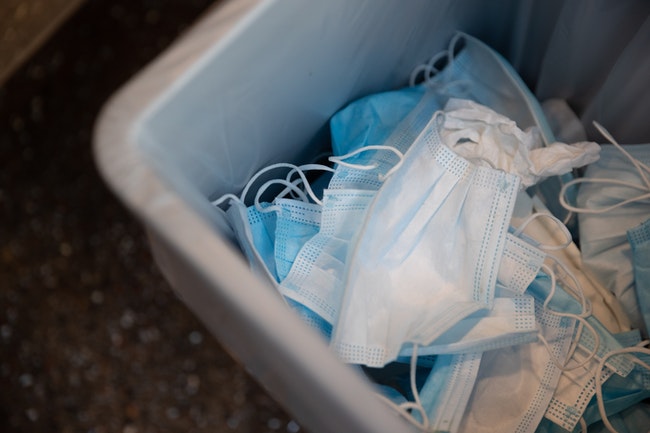
While the mask mandate is lifted in Oregon, testing for Covid will continue.(Amanda Loman/Salem Reporter)
Oregon is shifting its strategy to deal with the coronavirus, with the lifting of most mask mandates.
At midnight on Friday, masks will no longer be required in schools and public places in Oregon, Washington and California.
“We can close the emergency phase of Oregon’s Covid response,” Patrick Allen, director of the Oregon Health Authority said during a news conference on Friday. “That’s a watershed moment in this pandemic.”
The move comes amid a dramatic decline in cases and hospitalizations thanks in part to a high vaccination rate among Oregonians and widespread compliance with Oregon’s mask requirements, he said.
To date, more than 6,850 people in Oregon have died from Covid-19, the seventh lowest rate in the country, according to Dr. Dean Sidelinger, the state’s epidemiologist.
Oregon has the third lowest per capita case rate: Nearly 700,000 people have tested positive since the pandemic began in Oregon in late February 2020. Hospitalizations have declined at a “dizzying” rate since the beginning of the year, Sidelinger said. At the peak of the omicron surge in January, 1,130 people with Covid were hospitalized in Oregon. On Friday, that figure was just over 260, a decrease of more than 75%. That’s far below the 400 mark officials said the state needed to achieve before masks could come off.
The lifting of the mask mandate will not be universal. They will remain mandatory in health care settings such as hospitals and nursing homes, in airports and on public transit such as buses.
For some people, the policy change may mean a return to business as usual, while others may want to continue masking up, public health officials said Friday.
“There are people who may still need to be protected,” said Chunhuei Chi, professor of the Global Health Program at Oregon State University.
They include the elderly, immuno-compromised and people who cannot get vaccinated, Chi said.
Businesses such as grocery stores, retail outlets and concert venues have the option of requiring masks for customers and employees.
They will be optional in schools, with the Portland and Beaverton school districts lifting their requirements on Monday, according to Colt Gill, director of the state Department of Education. Gill said during the news conference that “some” districts were extending their mandates until after spring break – the third week of March for most districts.
When pressed about those districts, he referred reporters to his department for more information. Marc Siegal, who handles communications, responded by pointing to a news article that said the Parkrose School District will extend the mask mandate to the end of spring break. District officials didn’t respond to a request for comment Friday afternoon.
Other school districts – like Springfiend and McKenzie in Lane County – will make masks optional but will strongly recommend them.
The vaccination requirement for schools – and health care settings including long-term care – will remain. But on April 1, with the ending of Gov. Kate Brown’s emergency declaration, vaccinations will no longer be required of state workers in most agencies, ranging from the Oregon Corrections Department to the Transportation Department.
Oregon’s vaccination rate – 83% of adults have had one dose – is the 18th highest in the country, Sidelinger said. And 44% have received a booster shot. Sidelinger said that more than 80%of Oregonians are now protected against Covid either because they’ve been infected, are fully vaccinated, or both.
Not yet at endemic stage
But that doesn’t mean that the coronavirus is akin to influenza, Sidelinger said.
“The pandemic is not yet over,” Sidelinger said. “We will continue to see new cases of disease and we fully expect new variants to emerge.”
The state will continue to test wastewater samples for the virus in more than 40 communities through a program at OSU. It will also maintain a stockpile of vaccines to be able to administer 25,000 doses a day.
But many doses are nearing their expiration date: about 38,000 doses are expiring this month and 83,000 will expire in April, according to Rudy Owens, a health authority spokesman. The Pfizer, Moderna and Johnson & Johnson vaccines last about six months, depending on storage.
The state will maintain the ability to test 130,000 people a week. Health officials plan to distribute tests to areas with high rates of poverty so that students and residents can get tested when they need it, officials said.
Allen praised Oregonians for following state guidance. Allen said the measures saved an estimated 5,700 lives, but he acknowledged that the state did a poor job of serving all populations equally.
“The pandemic also displayed the shortcomings of government agencies and our health care system to care for everyone equitably,” Allen said. “It revealed the fault lines of distrust within our communities.”
A February report by the Oregon Health Authority showed that Pacific Islanders, Black Oregonians, American Indians and Alaska Natives were much more likely to become infected with the virus early in the pandemic. The report said that that through April 2021, Hispanics, in particular, were much more likely to be hospitalized or die than white people.
The gap between racial and ethnic minorities and white people in rates of infection, hospitalization and death narrowed after that, the report showed.
Erica Heartquist, health authority spokeswoman, said in an email those disparities reflected “centuries of structural and institutional racism that has resulted in persistent inequities.”
“Workplace exposures may have also played a role in the Covid-19 inequities in Oregon,” Heartquist wrote.
Going forward, the agency intends to focus on “high-priority communities” by working with nonprofits that serve minority groups, with a goal of reducing health care inequities, the agency said. And If a dangerous new variant emerges, like delta or omicron, the state could revert back to mandates, officials indicated.
“We need to be prepared to step up our efforts in the future,” Sidelinger said.
Oregon Capital Chronicle is part of States Newsroom, a network of news bureaus supported by grants and a coalition of donors as a 501c(3) public charity. Oregon Capital Chronicle maintains editorial independence. Contact Editor Les Zaitz for questions: [email protected]. Follow Oregon Capital Chronicle on Facebook and Twitter.









